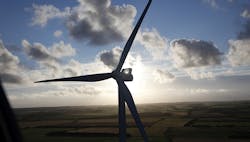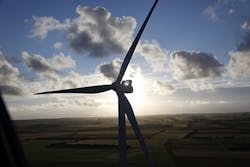Aging Wind Turbines Pose Recycling Challenges
Wind energy currently supplies 15% of electricity used in the European Union (EU). This is set to rise to 50% by 2050 under the European Commission’s long-term decarbonization strategy.
However, the bloc is facing a serious, more short-term issue: how to recycle the blades from decommissioned wind turbines.
According to trade body WindEurope, Brussels, the first generation of wind turbines are nearing the end of their operational life. The organization estimates that 14,000 wind turbine blades — weighing an estimated 40,000–60,000 mt — will be decommissioned by 2023.
While 85–90% of wind turbines’ total mass is readily recyclable, the blades pose technical, economic and regulatory challenges.
[pullquote]
The problem is their composite structure. While material compositions vary between blade types and manufacturers, they typically contain a host of different materials, including: glass or carbon reinforcing fibers; polymer matrices with thermosets such as epoxies, polyesters, vinyl esters, polyurethane, or thermoplastics; a sandwich core of balsa wood or foams of, e.g., polyvinyl chloride or polyethylene terephthalate; structural adhesives such as epoxies and polyurethane; coatings including polyester and polyurethane; and metals such as copper or aluminium wiring and steel bolts.
Currently, cement co-processing is the main recycling route. To find more sustainable alternatives, the European Chemical Industry Council (Cefic), WindEurope and the European Composites Industry Association (EuCIA) have collaborated on a new report called “Accelerating Wind Turbine Blade Circularity.”
The three trade bodies strongly support increasing and improving composite waste recycling through the development of alternative recycling technologies that produce higher value recyclates and enable production of new composites.
Figure 1. While most of the overall wind turbine struture can be recycled, the blades pose particular problems. Source: Vestas
The report looks at the relative merits of cement co-processing, mechanical grinding, pyrolysis, high-voltage pulse fragmentation, solvolysis and fluidized beds. Each has its drawbacks, however. For example, the cement route damages composite fibers so they can’t be re-used, while mechanical grinding requires a large facility but the quality of recyclates is low because they contain other materials. Pyrolysis has relatively good economics but the fibers recovered are lower quality than the originals. High-voltage pulse fragmentation is still at the lab and small pilot scale. Solvolysis requires high temperatures and pressures as well as solvent recovery. Plus, not all of the fibers can be recycled this way. Fluidized beds face issues with fiber degradation and challenges of scale up. In addition, most of these options are not yet widely available at industrial scale, or cost-competitive.
In many cases the recycled material can’t compete with the price of virgin materials. As an example, the report says the €1–2/kg ($1.1–2.2/kg) cost of virgin glass fiber doesn’t make the recovery of it as a standalone product economically competitive.
On the other hand, the report envisions that the recovery of the whole composite materials into chemical building blocks will represent a viable route. This is based on the recovery of pyrolysis oils and of chemicals obtained through gasification, which the report notes is happening in other large-volume sectors and value chains such as plastic waste.
The report also highlights the different regulatory regimes in force in the EU at the moment.
In Germany, for example, turbine blades can’t be landfilled because their total organic content exceeds 5%. Instead, a cement co-processing plant was established which uses around 15,000 mt/y of composite waste annually, two-thirds of which comes from wind turbine blades. The plant’s capacity is 30,000 mt/yr and has a gate fee around €150/mt ($170/mt).
Meanwhile in the Netherlands, composite waste is banned in principle from landfills. However, if the cost of alternative treatments is higher than €200/mt ($226/mt) an exemption applies. According to a WindEurope survey, the cost of mechanically recycling wind turbine blades in the Netherlands ranges between €500 and 1,000/mt ($567–1,034/mt) including onsite pre-cut, transport and processing. Mechanical recycling itself costs €150–300/mt ($170-340/mt). So, landfill disposal of wind turbines is allowed.
To counter these problems, the report calls on the EU for increased research and innovation funding to diversify and scale up composite recycling technologies, to develop new high-performance materials with enhanced circularity, and to improve lifecycle assessments.
“Investing in renewable energy production and circular solutions should be one of the key drivers of the post-COVID-19 economic recovery,” says Cefic director general Marco Mensink. “I am very proud of the partnership we have built with the wind energy supply chain to come up with an effective solution to recycling wind blades. This shows that cross-industry and value chain alliances are a very powerful tool for speeding up innovation and scaling up cutting edge technologies,” he adds.
Seán Ottewell is Chemical Processing's editor at large. You can email him at [email protected].


